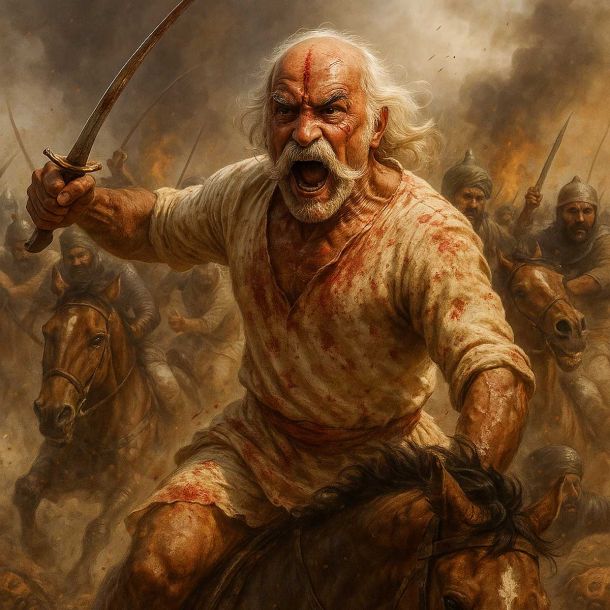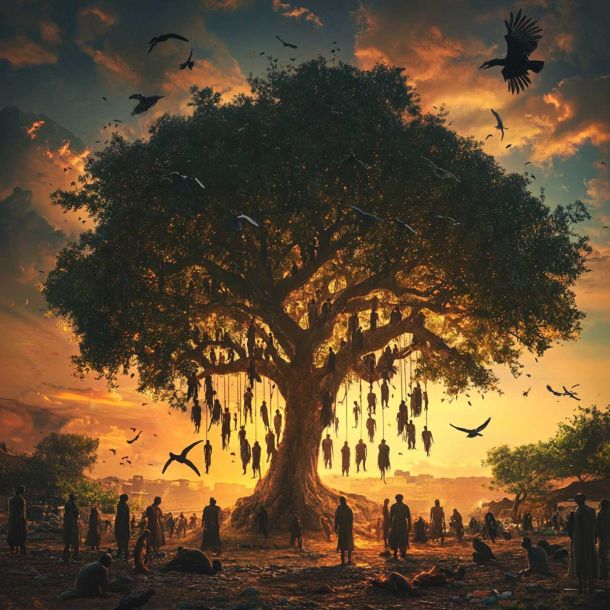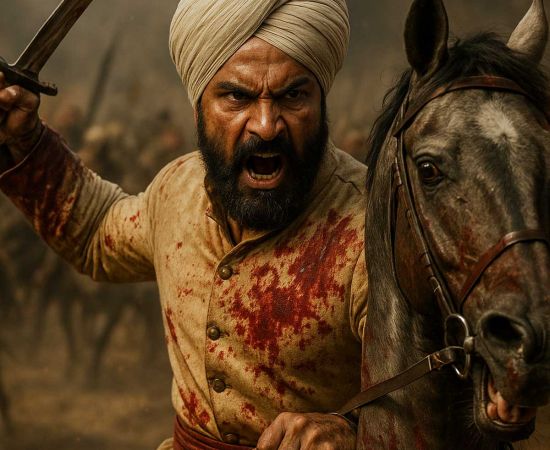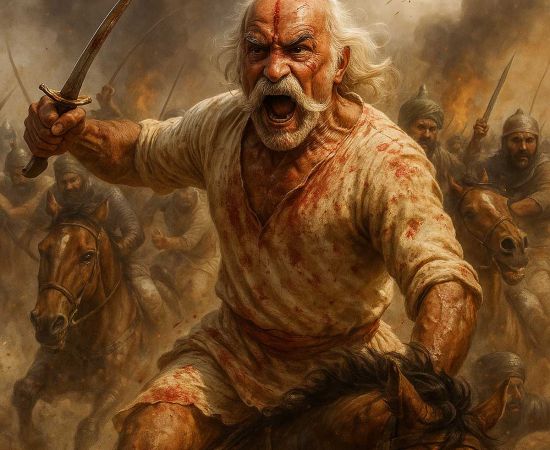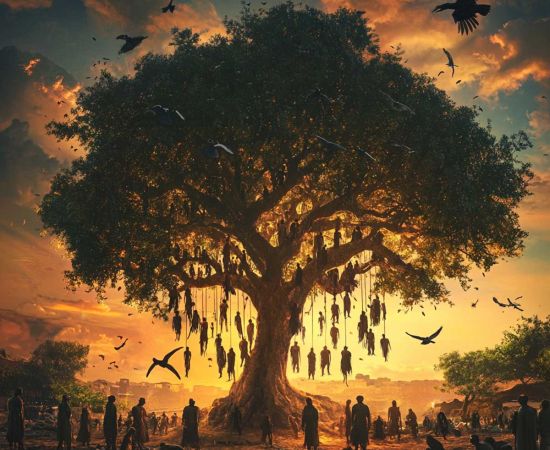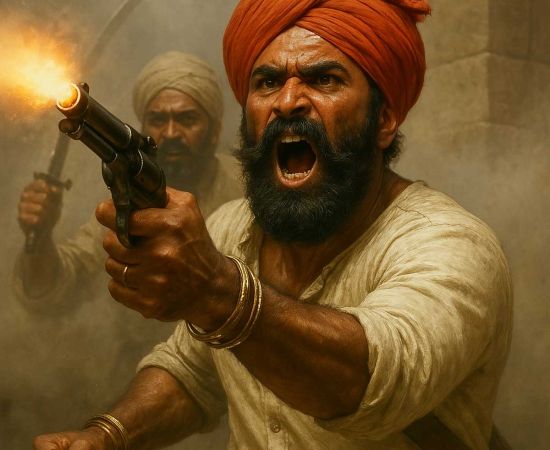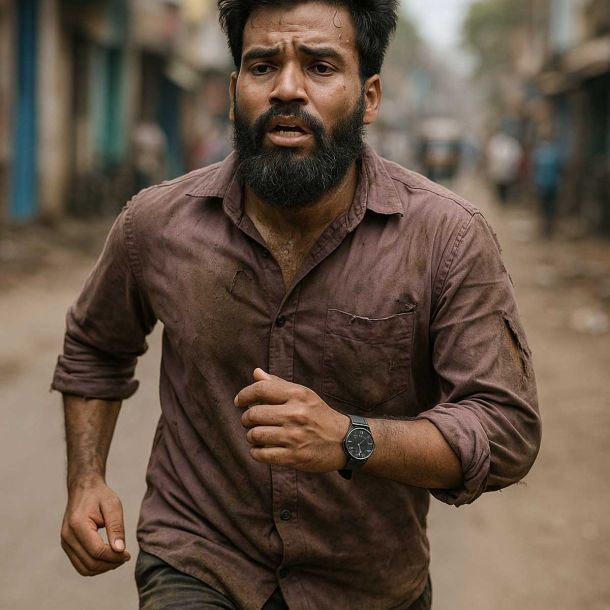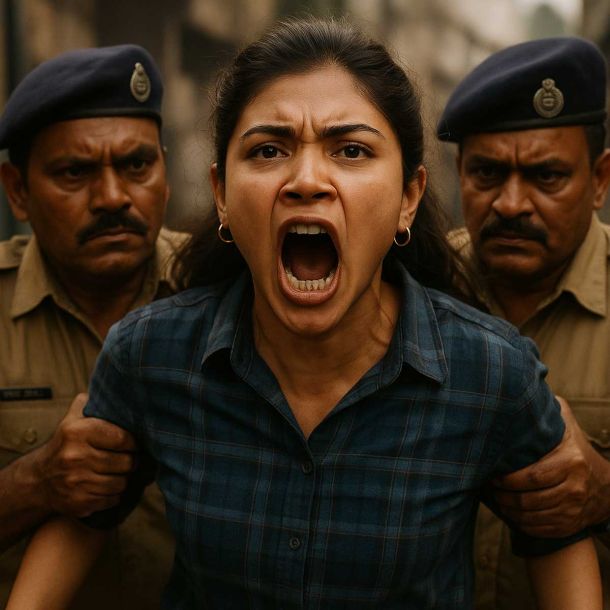MORE COVERAGE
Twitter Coverage
Satyaagrah
Written on
Satyaagrah
Written on
Satyaagrah
Written on
Satyaagrah
Written on
Satyaagrah
Written on
JOIN SATYAAGRAH SOCIAL MEDIA
“Pannirayiramtirumudi-tiruttina-kalabham”: In 1323, Malik Kafur raided the Ranganathswami Temple in Thiruchirapalli to slaughter 12,000 people! History of how the deity was saved by the local priest & devotees, and how Marxist hid this information

The Bhoomi Pujan for the Ram Temple in Ayodhya resonated as a momentous climax to the Ram Janmabhoomi movement, a saga deeply intertwined with India's cultural tapestry. Amidst the sacred rituals, the diverse elements contributing to the ceremony were drawn from holy Hindu sites scattered across the nation. Notably, the inclusion of materials from Srirangam carried profound significance, shedding light on a poignant chapter in Vaishnavism's past.
In this sacred event, the inclusion of water from the banks of the river Cauvery in Srirangam symbolizes a deeply rooted connection between the north and the south, the confluence of traditions and beliefs. Srirangam, nestled along the Cauvery's shores, holds a distinct place in the hearts of Vaishnavites, the ardent followers of Lord Vishnu. The intricate layers of devotion and history intertwine as the sacred soil and water join the tapestry of reverence during the Bhoomi Pujan.
The Ranganathaswamy Temple, standing majestically in Srirangam, emerges as a testament to centuries of unwavering devotion. As the oldest among the 106 earthly Vaishnava Divya Desams, it commands reverence from the faithful. Embedded in the verses of the Nalayira Divya Prabhandam, a profound work accredited to the 12 Alvars, Srirangam becomes more than a geographical location—it transforms into a spiritual nucleus.
To Vaishnavites, Lord Ram, the 7th avatar of Vishnu, holds profound significance, threading the narrative of their faith. The Bhoomi Pujan, by incorporating elements from Srirangam, not only pays homage to Lord Ram but also unveils a tale of resilience—of a sacred site that weathered historical storms, particularly the Islamic invasions during the reign of the Delhi Sultanate.
However, the serene façade of Srirangam has weathered storms of historical significance, notably during the Islamic invasions by the Delhi Sultanate. The echoes of that tumultuous period still resonate within the temple's walls, bearing witness to the trials faced by Vaishnavites. It is crucial to delve into this chapter with a solemn acknowledgment of the pain endured by this sacred site.Boldly confronting historical truths, the Islamic onslaught on Srirangam remains etched in the annals of Vaishnavism's history. The desecration and pillaging during those dark times stand as a testament to the resilience of faith and the enduring spirit of those who safeguarded the sanctity of the Ranganathaswamy Temple.
The inclusion of Srirangam's offerings in the Bhoomi Pujan serves not only as a symbolic gesture but also as a poignant reminder of the challenges faced by sacred sites like Srirangam. As we celebrate the triumph of the Ram Janmabhoomi movement, let us not forget the silent sacrifices endured by places like Srirangam, echoing the sentiments of countless devotees who weathered storms to preserve the sanctity of their beliefs.
Not just a spiritual haven, the Ranganathaswamy Temple in Srirangam boasts the title of the largest functioning Hindu temple globally. Its towering presence not only resonates with the devout but also holds within its sacred walls an extensive historical tapestry, meticulously chronicled in the “Kovil Olugu.” This monumental record unravels the temple’s journey through the corridors of social, political, and cultural evolution, spanning epochs from the Cholas to the East India Company's annexation in the 18th century.
The “Kovil Olugu” stands as an invaluable testament to Srirangam's rich history, etching narratives in the Manipravala dialect of Tamil—a linguistic vessel carrying the echoes of centuries. Its vast scope, stretching from the Chola era through the tempestuous times of the Delhi Sultanate, encapsulates the evolution of a spiritual nucleus amid the ebb and flow of history. Each page becomes a portal to bygone eras, revealing the temple's resilience in the face of cultural shifts and political upheavals.
Yet, within this treasure trove of historical documentation, there exists a noticeable void—an untold tale of Srirangam's tryst with the Delhi Sultanate. Despite the richness of the “Kovil Olugu,” modern historians have largely skirted this critical chapter, leaving an enigmatic gap in the comprehensive understanding of the temple's journey through time.
The omission of Srirangam’s interaction with the Delhi Sultanate in contemporary historical narratives raises intriguing questions. Was it an oversight driven by a reluctance to delve into the painful scars of history, or did the enormity of the task deter scholars from unveiling this chapter? As we explore the tapestry of the Ranganathaswamy Temple’s past, the unanswered questions surrounding its encounter with the Delhi Sultanate invite us to embark on a journey of historical exploration, peeling back the layers of time to uncover the obscured narratives that lie within the shadow of the temple's colossal presence.
The “Kovil Olugu,” while a comprehensive chronicle, awaits a modern historian’s pen to bridge the gap, to lend a voice to the muted whispers of Srirangam's past during the tumultuous times of the Delhi Sultanate. Until then, the untold tale remains a challenge and an opportunity for those who seek a more complete understanding of the intricate interplay between faith and history within the hallowed precincts of this magnificent temple.
The First Islamic Invasion of Srirangam: A Dark Chapter Unfolds
In the annals of Srirangam's history, a dark chapter unfolds with the first Islamic invasion, shattering the serene echoes of Vaishnavism that once reverberated under the patronage of the Cholas and Pandyas. The temple town, despite enduring political upheavals and wars, stood as the fountainhead of Vaishnavism, its eminence undisturbed by the shifting tides of power.
Under the rule of the Cholas and Pandyas, Srirangam thrived as the epicenter of Vaishnavism, richly patronized by the ruling powers of the day. However, the year 1310 marked a pivotal moment as the death of Malaverman Kulasekara Pandya I plunged the region into a protracted struggle for succession among his sons. Unfortunately, this internal strife coincided with the ominous march of the Delhi Sultanate towards the southern realms.
In 1967, Dr. V.N. Hari Rao's authoritative work, "History of Srirangam Temple," chronicles this tumultuous period, shedding light on the confluence of political instability and the encroaching shadow of the Delhi Sultanate.
At the forefront of the Sultanate's campaign was Malik Kafur, one of Alauddin Khilji's formidable slave-generals. By early 1311, Kafur had already subdued the Kakatiyas, Yadavas, and the Hoysala kingdoms, compelling them into tributary states of the Delhi Sultanate. The Pandya country, referred to as Ma’bar in historical accounts, became the next target of Kafur's ambitions.
In March 1311, Kafur's army breached the Pandya empire through the pass at present-day Thoppur, initiating a chain of events that would cast a long shadow on Srirangam. His initial attempt to capture Vira Pandya, the son of Kulasekara Pandya, proved unsuccessful. Undeterred, Kafur redirected his focus, first sacking the temple in Chidambaram before turning his attention to the famed Srirangam, renowned for its opulence.
Kafur's army, like an ominous storm, breached the northern enclosures of Srirangam in their quest for wealth. The Vaishnava saints within the sacred precincts found themselves overpowered, their chants drowned by the tumult of invasion. The temple's treasury, a repository of centuries-old offerings, fell victim to the invaders' greed, and the riches of Srirangam were callously stolen.
As April of 1311 unfolded, Malik Kafur's armies commenced their journey back to Delhi, leaving behind a scarred landscape and the echoes of Srirangam's desecration. Meanwhile, the internal strife within the Pandya empire persisted, casting shadows on the temple town's future. Over the next decade, a slow and arduous process unfolded—the gradual restoration of the Ranganathaswamy's wealth. Yet, in the corridors of time, only a handful were privy to the knowledge that the events of 1311 were but a prelude to a tragedy that loomed on the horizon.
The Second Islamic Invasion of Srirangam: A Glimpse into Tumultuous Times
The year 1320 witnessed a seismic shift in the political landscape as the Khilji dynasty crumbled under the weight of internal dissent. With the support of the Governor of Punjab, Ghazi Malik, a descendant of Indian Turkic slaves, seized the reins of power. Renaming himself Ghiyasuddin Tughluq, he ushered in the Tughluq dynasty. Ambitious and seeking complete control over the Deccan's tributary states, Ghiyasuddin initiated an ambitious campaign in 1321, sending a colossal army to conquer the southern peninsula.
At the helm of this expedition was his eldest son, Ulugh Khan, later known as Muhammad bin Tughluq. The 1321 venture faced defeat at Warangal, but undeterred, Ulugh Khan's forces, by 1323, successfully captured the city in a subsequent campaign. With the Deccan under their control, the Tughluqs turned their attention towards Ma’bar, the region we now recognize as present-day Tamil Nadu.
Their conquest unfolded systematically—first, the capture of Tondaimandalam, and then the relentless march towards Srirangam. The condensed English version of "The Koyil Olugu" (1954), authored by T.S. Parthasarathy, PRO Indian Railways and published by Tirumala Tirupati Devasthanams, serves as a historical beacon, illuminating the shadows of this turbulent period.
The year 1323 saw Ulugh Khan's forces approaching Srirangam, their sights set on the revered temple. The Koyil Olugu encapsulates the unfolding drama, a narrative etched in the stones of history. The fate of Srirangam once again hung in the balance as the forces of the Tughluq dynasty converged upon this sacred land.
The haunting specter of the second Islamic invasion of Srirangam looms large, a heart-wrenching chapter etched in the sorrowful narratives of revered Vaishnava works — the Guruparamparai, the Prapannamritam, the Acaryasukti Muktavali, and the Kovil Olugu. These poignant accounts, unanimous in their testament, chronicle the relentless cruelty that transpired in the tragic year of 1323.
Picture a sacred temple festival, an ode to devotion, unfolding amid the idyllic surroundings of Srirangam. The divine Ranganathaswamy idol, the Urchavar Azhagiya Manavala Perumal, took center stage in a sacred procession from the main temple to a shrine on the Cauvery's banks. Amidst this joyous celebration, 12,000 Sri Vaishnavas, souls deeply devoted, gathered in radiant spirituality. Yet, the joyous notes turned to a chilling symphony as the ominous news of Ulugh Khan's ruthless army's advance reached their ears.
Confronted with the imminent danger, Srirangarajanathan Vaduladesika, the noble chief priest of the Ranganathaswamy temple, faced a harrowing choice. Swiftly, he dispersed the vibrant procession and orchestrated the secret transport of the sacred idol and the temple's precious jewels further south — a desperate attempt to shield them from the impending onslaught.
Despite these valiant efforts, Ulugh Khan's merciless army descended upon Srirangam, violating the sacred haven with ruthless desecration. The very soul of the spiritual refuge was tainted, its sacred halls echoing with the cruelty that befell it.
In the aftermath of discovering that the revered deity had eluded his vengeful grasp, an enraged Ulugh Khan issued a chilling and merciless decree. His troops were ruthlessly ordered to behead the 12,000 Sri Vaishnavas who had gathered in fervent devotion. The Kovil Olugu poignantly encapsulates this heart-wrenching incident as “Pannirayiramtirumudi-tiruttina-kalabham” — the invasion that claimed 12,000 innocent souls, forever staining the annals of Srirangam's history with tragedy.
For a span of a couple of years, the sacred idol embarked on a poignant journey, seeking refuge from shrine to shrine across the landscapes of South India. A soul in exile, the Urchavar Azhagiya Manavala Perumal traversed the southern terrain, eluding the nefarious grasp of the Muhammadan invaders. It was a tumultuous period, a heartbreaking saga of displacement, as the idol sought sanctuary, eventually finding solace in the secure haven of Tirumala. The sacred wanderer spent a painful 48 years in exile, far from its rightful abode.
The year 1371 marked a poignant chapter in this enduring saga. Finally, after years of wandering and suffering, the idol was safely taken back to Srirangam. The merciful arms of the Vijayanagar empire embraced the sacred relic, and it was ceremoniously reinstalled at the temple, bringing an end to its painful journey of exile. The sanctum sanctorum welcomed back its divine resident, and the echoes of resilience and redemption resonated through Srirangam.
The second sacking of Srirangam cast a long and ominous shadow over the pages of Vaishnavite history. The Tughlaqs, holding sway over Ma’bar directly from Delhi, imposed a reign of terror that endured for over a decade. The once serene spiritual abode now groaned under the weight of oppressive rule, its sanctity tainted by the invaders' malevolent presence. The sacred grounds of Srirangam became a battleground of cultural desecration, a dark period where the very essence of Vaishnavism faced its sternest test.
As if the horrors were not enough, one of Ulugh Khan’s chieftains chose to leave a lasting scar on Srirangam. He defiled the towering gopurams of the temple, once majestic symbols of divine glory, reducing them to mutilated remnants. Adding insult to injury, he audaciously set up his residence right opposite the sanctum sanctorum, mocking the sacred space with his malevolent presence. The very soul of Srirangam bled under this dark residency, a symbol of the brutality that had befallen this once-hallowed land.
For a few years, the villages near Srirangam were ruled by a Muslim chief. It was a sad time for the area, as this leader brought darkness to the once peaceful surroundings. The people felt the weight of his harsh rule, and life in and around Srirangam became a difficult reality.
Stories circulated quietly about the Muslim chief who, during his time in the temple, suffered from many diseases. The walls that once echoed with prayers now witnessed the struggles of a troubled leader. The pure temple, once full of positive energy, now carried the scars of its suffering.
The Muslim chief, troubled by his ailments in the sacred Ranganathaswamy temple, later moved to Kannanur. Unfortunately, this new place wasn't a refuge of peace but a site of more harm. He disrespectfully damaged the Poysalesvara temple, a holy place for many. The sacred chants were replaced by a different call to prayer as he converted the once-honored space into a mosque. Another sacred place faced the cruelty of change.
After enduring a ruler's dark period, the Ranganathaswamy temple found hope through Bukka Raya the First from the Vijayanagar empire. Hailing from the famous Sangama dynasty, this noble leader made it his mission to restore the temple's purity and glory. The efforts to rebuild brought life back to the desolate temple, erasing the marks of disrespect and signaling a triumphant return to its original divine beauty.
The Srirangam temple is a sacred place for Vaishnava followers in South India. It's like a bright light guiding countless devotees. But, surprisingly, it carries a heavy burden of an untold tragedy—a dark time when it faced challenges from Islamic invaders. What's even more surprising is that this sad part of its history is missing from our history books and the writings of well-known Indian historians. The quietness about the temple's struggles under Islamic rule makes us wonder about the stories we've been told.
The pain felt in the Srirangam temple has been pushed aside and forgotten over time. The very center of Vaishnavism faced tough times, yet it seems like no one heard its cries in the stories we read. The temple's sorrow quietly unfolds, hidden from public view, and its pain remains unspoken.
It's a big sadness that the hard times Srirangam went through with Islamic invaders aren't mentioned in our history books. This intentional silence makes us question why this painful part of the temple's past is kept hidden. The suffering the temple faced under Islamic rule, a significant part of its story, stays in the shadows, buried in collective silence.
Our usual history keepers, the mainstream Indian historians, seem to look away from this painful truth. Avoiding discussions about Mughals and other Muslim rulers adds another layer to this hidden history. We wonder: Why is Srirangam's tough time not talked about openly, lost in silent suffering?
Trying to honestly look at what Mughals and other Muslim rulers did often leads to accusations of being choosy. Examining this part of history becomes a touchy subject, wrapped in feelings and loyalties. The hesitation to look closely and present a fair view of this history makes us question the way we talk about our past.
The influence of Marxist historians dominating Indian academia plays a significant role in distorting the history we share with our children. Their focus on preserving Nehruvian secularism has led to the creation of false narratives and imaginary stories of religious tolerance over many decades. Imagine if post-war German society had chosen to ignore the Holocaust in their history books—would reconciliation have been possible? The first crucial step in healing historical wounds and fostering reconciliation is to acknowledge the crimes of the past. Unfortunately, the decision to bury dark chapters like the sacking of Srirangam only deepens the religious divides.
Blaming Marxist historians who dominate Indian academia is not an exaggeration when it comes to the distortion of the history taught to our children. Their main goal of upholding Nehruvian secularism has led to the creation of stories that aren't true and tales of religious tolerance that never happened, stretching across decades. Think about post-war Germany; if they had decided to hide the Holocaust in their history books, could reconciliation have happened? The crucial first step to healing historical wounds and making amends is acknowledging the crimes of the past. Sadly, the choice to bury dark chapters like the sacking of Srirangam only widens the religious gaps.
Pointing fingers at Marxist historians dominating Indian academia isn't an exaggeration when it comes to the twisted history we teach our children. Their main focus on preserving Nehruvian secularism has led to the creation of stories that aren't true and tales of religious tolerance that never happened, spanning decades. Imagine if post-war Germany had chosen to ignore the Holocaust in their history books—would reconciliation have been possible? The crucial first step in healing historical wounds and fostering reconciliation is to acknowledge the crimes of the past. Unfortunately, the decision to bury dark chapters like the sacking of Srirangam only deepens the religious divides.
The influence of Marxist historians dominating Indian academia has significantly shaped the distorted history we share with our children. Their focus on preserving Nehruvian secularism has led to the creation of stories that aren't true and tales of religious tolerance that never happened, spanning decades. Consider post-war Germany; if they had decided to hide the Holocaust in their history books, could reconciliation have happened? The crucial first step in healing historical wounds and fostering reconciliation is to acknowledge the crimes of the past. Sadly, the choice to bury dark chapters like the sacking of Srirangam only widens the religious gaps.
 Support Us
Support Us
Satyagraha was born from the heart of our land, with an undying aim to unveil the true essence of Bharat. It seeks to illuminate the hidden tales of our valiant freedom fighters and the rich chronicles that haven't yet sung their complete melody in the mainstream.
While platforms like NDTV and 'The Wire' effortlessly garner funds under the banner of safeguarding democracy, we at Satyagraha walk a different path. Our strength and resonance come from you. In this journey to weave a stronger Bharat, every little contribution amplifies our voice. Let's come together, contribute as you can, and champion the true spirit of our nation.
 |  |  |
| ICICI Bank of Satyaagrah | Razorpay Bank of Satyaagrah | PayPal Bank of Satyaagrah - For International Payments |
If all above doesn't work, then try the LINK below:
Please share the article on other platforms
DISCLAIMER: The author is solely responsible for the views expressed in this article. The author carries the responsibility for citing and/or licensing of images utilized within the text. The website also frequently uses non-commercial images for representational purposes only in line with the article. We are not responsible for the authenticity of such images. If some images have a copyright issue, we request the person/entity to contact us at This email address is being protected from spambots. You need JavaScript enabled to view it. and we will take the necessary actions to resolve the issue.
Related Articles
- "Love Jihad in 1565": Sulaiman Karrani orchestrated a sinister plot, ensnaring Kalapahad, a once valiant & staunch Hindu General unbeaten in battle, by using his daughter. The tragic tale unfolds as power, betrayal, and conversion reshape Orissa's history
- As Chhaava reignites debates, Islamists glorify Mughal ‘victories,’ yet Aurangzeb’s heirs sell tea in slums while Shivaji’s descendants serve in Parliament—Sultana Begum, claiming Red Fort, lives on a ₹6000 pension, her plea dismissed as a “waste of time"
- “Everything you’ve ever wanted is on the other side of fear”: Mula Gabharu, one among phenomenal patriotic women who fought with Mughals for her husband, for motherland, called the people of Assam to fight Mughals by taking Ahom sword in their hands
- King Uthram Thirunal Marthanda Varma of Travancore presented Ivory Throne and a stool as a gift objects to Queen Victoria, become an integral part of Queen's interiors
- Father of the Nation! Absolutely not. Mohandas Karamchand Gandhi was not the father of the nation either officially or otherwise
- "Achievement in space, politics on Earth": While ISRO's Chandrayaan-3 etches a new chapter in space history, the Congress's rush for credit speaks volumes, amidst lunar triumphs, memories of overlooked funding pleas during the UPA era cast long shadows
- “Mostly unknown but the greatest Indian Revolutionary”: Rash Behari Bose, Neta of Netaji Subhash Chnadra Bose, most progressive revolutionary who prepared all the field and ammunition for Bose to carry out the biggest revolution against Britishers
- Maligning of India by British Raj since the 1800s
- Jagannath Temple administration issues clarification on proposed sale of temple lands
- Pt. Madan Mohan Malaviya’s independent ‘Note’ to the Industrial Commission of 1916: India’s Industrial Heritage
- ‘The Koh-i- Noor’ or “Two and half days’ food of the entire world” as valued by Mughal Emperor Zahiruddin Muhammad Babur is one Gem in a history that is not known to have ever been bought or sold, it always changed hands as a result of conquest
- Theft on a Grand Scale - Britain stole $45 Trillion from India and lied about it. Indian money developed Britain and Other Countries
- If only India’s partition chilling wound was not enough, Gandhi did his last protest again only to blackmail India into giving 55 crores to Pakistan, dragged Hindu, Sikh refugees seeking shelter in mosques to die in cold: And we call him Mahatma, not for
- History books should teach India’s civilisational, linguistic heritage, not unfounded claims: Parliamentary Committee meets to discuss NCERT books
- Add Vedas and review freedom fighter's portrayal in School textbooks: Parliamentary Committee on Education

